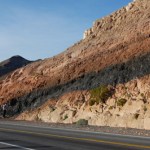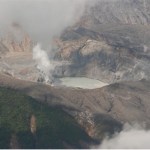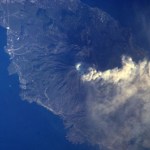volcanoes in the media
The ash plume from the 2010 Eyjafjallajökull eruption.
To say that the Eyjafjallajökull eruption has become the most significant volcano-related news story of the year would be an understatement. There has been wall-to-wall coverage on every major media outlet, dissecting everything from the effect of ash on jets, to the effect of ash on people, to wildly premature commentary on the climatic effect of the eruption to the potential place in history of this event. The eruption is affecting a wide swath through society: the European economy may take a hit of billions of dollars due to…
A brief, non-volcano-related note, but sometime between 12:30 and 1 PM EDT today, Eruptions will pass 1,000,000 page views since joining ScienceBlogs in March of 2009. I wanted to thank everyone who has made the blog such a fun thing to do and who pick up on reporting the events when I'm swamped. You've made it into a community of volcanophiles unto itself.
Now, back to the volcanoes!
Lots to do!
Tourists flock to the Eyjafjallajökull-Fimmvörduháls in Iceland.
The media does love the term "supervolcano", and a number of Eruptions readers sent me a link to the article on the dreaded submarine "supervolcanoes". I would delve into this article from Live Science, but it sadly again does a dreadful job with a lot of this - remember, "supervolcano" is a made-up word by the BBC with no strict definition, so trying to say there are a dozen supervolcanoes worldwide is just silly. And why does it take multiple paragraphs and multiple mentions of "scientists" before they get a…
Quick hits for a Monday morning (however, the week did have a good start).
Lava fountaining on March 27, 2010 at the Eyjafjallajokull-Fimmvörduháls eruption in Iceland.
The Eyjafjallajokull-Fimmvörduháls eruption is still going strong with two active fissure - and a lot of tourists poking around as well. If you watch the webcams closely, you can even see the cars and hikers trekking up near the erupting basaltic fissure (except today, as there seems to be a blizzard). Not to say that people are getting a little, well, nonchalant, but there is a story of serving meals cooked on lava up…
Mars Reconnaissance Orbiter image of a potential plume on Pavonis Mons.
There are reports tonight that the Mars Reconnaissance Orbiter photographing the Martian surface noticed an odd plume near the summit of Pavonis Mons. The initial guess was that this plume might have been fog or an new impact on the Martian surface, but the continued presence of the plume might suggest that it is not a transient feature. One suggestion is that these could be a volcanic plume.
Now, Mars has been very volcanically active in the past - in fact the youngest flows could be as young as 20 million years old, so…
Map showing the location of submarine volcano Marsili, near the Italian coast. Image from INGV.
The subject of submarine volcanism near Italy has come up before here on Eruptions but now it has made the jump into the worldwide media after some claims made by Enzo Boschi, president of the National Institute of Geophysics and Volcanology (INGV).
The long and short of what I can tell from the articles is that Marsili, a submarine volcano in the Tyrrhenian Sea, could be a threat to create a significant tsunami that would hit Italy (amongst other Mediterranean countries). The volcano lies only…
Busy busy today, so just a brief update on the ongoing Fimmvörðuháls/Eyjafjallajokull eruption in Iceland.
The coalesced vent of the Fimmvörðuháls fissure eruption in late March 2010.
The eruption is still going, albeit potentially with a little less vigor than before - and you can watch it on the Vodafone webcam, along with these other webcams from Mila.is. Haraldur Sigurdsson says that the eruption may have peaked (Icelandic) and is ~25% less vigorous than it was a few days ago, but this could change without notice. A fairly significant, long, low scoria cone has formed and lava…
Alan Boyle, Science Editor for MSNBC.com, was kind enough to answer questions about science in the mainstream media after the fallout of the coverage of the Chilean earthquake.
Alan Boyle, science editor for MSNBC.com
Alan has been with MSNBC.com since 1996, covering science and technology. He has his own blog on space called the Cosmic Log. He's also won quite the array of awards including from the National Academies, the American Association for the Advancement of Science, the National Association of Science Writers, the Society of Professional Journalists, the Space Frontier Foundation,…
I'm still playing catch-up after my week in the desert, so I've seen a lot of articles I've wanted to mention ... but a certain other volcano has taken up a lot of my time. However, I will attempt to make amends for that now.
By the way, would you believe Ubehebe Crater was closed? How do they close a volcano, anyway? However, I did get a great snap of a welded tuff on the road outside of Shoshone, CA.
A strongly welded tuff near Shoshone, CA. The dark interior is remelted volcanic ash/tephra surrounded by less welded pink tuff with abundant pumice clasts. Denison student David Sisak is on…
The fissure vent eruption near Eyjafjallajokull in Iceland. Image by Ãorsteinn Gunnarsson, March 22, 2010.
It has been hard to keep up with the flood of news from the Eyjafjallajokull eruption in Iceland. Eruptions readers have done a good job with getting new images, videos and info up as they happen, so you might want to peruse the comments for those sorts of tidbits (along with discussion of what might be happening).
Here is the latest:
The eruption at Fimmvörduháls (considering the eruption is actually occurring between the ice caps) could last weeks to months, which isn't too…
Did I mention its a busy week?
The lava lake at Erta'Ale in 2008. Image courtesy of Stromboli Online.
Our Icelandic saga continues, with more earthquakes and more speculation/information on the parts of Eruptions readers. Keep up the discussion - I'll be fascinated to see who turns out to get closest to what actually happens, prediction-wise. The seismicity has quieted somewhat again in the last 12 hours, so we wait eagerly to see what comes next. Remember, Iceland is the land where volcanoes helped change history, so it is always fun to talk Icelandic volcanism.
The NASA Earth Observatory…
Cleaning up some news ... busy week leading up to a field trip I am helping co-lead to Death Valley next week.
Ubehebe Crater in Death Valley, California
First off, I want to say how amazed I am at the great discussion that went on all weekend about the signs of potential activity in Iceland. It now appears that the earthquakes at Eyjafjallajökull may be waning, however the levels of seismicity have definitely bounced up and down over the last few days. However, the level and depth of the conversation is a testament to all volcanophiles out there. Nice job, folks.
For those of you into…
As many Eruptions readers read, the headlines produced by MSNBC for their coverage of the recent Chilean earthquake raised my ire. To me, it represented the sensationalism of the events - but as with all things media-related, there is a lot of opinions on the matter.
We were lucky to have Alan Boyle, science editor for MSNBC.com, comment on the fray and he has very kindly offered to take your questions about the coverage of science in the mainstream media. This is a unique opportunity for us to discuss how science is portrayed, the rationale for headlines and generally find out about how the…
Some news for a busy Tuesday:
The crater at Poas volcano in Costa Rica, taken February 25, 2010. Image courtesy of OVSICORI by Federico Chavarria.
After the MSNBC debacle, it is nice to see some good articles on why the Chilean earthquake was overall less disastrous than the Haitian earthquake, why the tsunami wasn't as large as predicted and why these earthquakes are not abnormal. There are a lot of factors involved - the location, depth, preparedness, wealth - so the comparison can be very telling in terms of both geologic and societal issues.
The other scientific fallout from the Chilean…
Long week, quick news:
Tiatia in Russia erupting in an undated photo.
The latest USGS/Smithsonian Institution
_blank">Weekly Volcano Activity Report is up. One interesting bit in the report is a thermal anomaly at
_blank">Tiatia in Russia (just north of Japan in the Kuril Islands) - a volcano for which I am unfamiliar. However, it sounds great according to the
_blank">GVP: "Tiatia volcano, one of the most impressive of the Kuril Islands, consists of a beautifully symmetrical cone that rises above the broad rim of an erosionally furrowed, 2.1 x 2.4 km wide caldera. The volcano…
Sakurajima Volcano in Japan, taken from the ISS on February 17. Image courtesy of Soichi Noguchi.
Eruptions reader Tim Stone sent me a link to the TwitPic feed for Soichi Noguchi, the Japanese astronaut currently on board of the International Space Station. The space traveller got a shot of Sakurajima from space, showing a beautiful plume drifting off - and great detail of the towns and roads near the volcano. Soichi has some other great shots (and comments to go with them), including my old haunt Seattle (with a comment about Ichiro), Mt. Aso - another Japanese volcano, and the Patagonian…
News!
Pakistan is home to the world's tallest mud volcano in the region of Balochistan - and its somewhat near the reports of an "eruption" earlier this week.
Guess what? Since Wednesday evening, seismicity at Yellowstone has dropped precipitously. The last batch of earthquakes on February 3rd were also back to deeper levels - 8-9 km depth - compared to the potential shallowing earlier in the week. I'm sure the caldera will keep us on our toes, but as of now, it seems to have settled down a bit.
Over in Pakistan, there is mounting evidence that the recent "volcanic" eruption reported as, in…
A 2010 mud flow from Lok-Batan, a mud volcano in Azerbijian.
So, first there was all the Yellowstone talk. Then the unsubstantiated reports of a volcanic eruption in a decidedly unvolcanic part of Pakistan (what part isn't), then submarine volcanism off Japan. Now, we have a nrews report about an eruption in Azerbijian. Luckily, although the headline implies a magmatic event, the text of the article shows that this is, in fact, a mud volcano. The mud volcano is called Lok-batan (or Lokbata) and has erupted quite a few times over the last 150 years, as recently as 2005. Azerbijian has quite a…
The plume from submarine volcano Fukutoku-Okanoba, erupting in February 2010.
Almost a year after the Hunga Tonga Hunga Ha'apai eruption, where an undersea volcano sprang forth from the deep - quite spectacularly, we have new footage of another undersea eruption. Fukutoku-Okanoba, off the coast of Minami Iwo, started to erupt yesterday (or, at least, erupt enough to manifest a plume out of the ocean). A Japanese coast guard vessel was able to capture the plume on video as it reached 100 m / ~300 feet. The plume appears to be dominated by white steam along with some grey ash mixed in.…
With all the talk of the current Yellowstone earthquake swarm, I thought it would worth it to write a post on the the structure and caldera - and why we get earthquake swarms that are structurally rather than magmatically-related.
First off, lets think about why calderas formed. This is relatively simple - at least superficially. The land (or volcano) above a magmatic system is partially supported by that magma, especially because magma is hot and buoyant. The isostatic support by the magma holds up the land surface or volcanic edifice, so when an eruption expels a large volume of magma, this…


